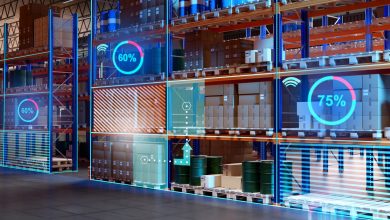
Suppose you want to stream a movie. About two gigabytes of data has to pass down the internet. If data were water, that would be equivalent to a bathtub.
Now suppose you want to, oh, operate a military drone somewhere in the Middle East.
You would need, just for the real-time video feed, hundreds of times that amount—each second.
Again, if data were water and the internet pipes, that would be equivalent to dumping a large swimming pool through the plumbing in one flush.
Can it handle it?
Need for a “new” internet
No, says Stelia, a company built around the belief that we need a “new” internet—not necessarily new cables and fiber optics—but a new way of organizing the way data is sent through existing hardware (although new cables are constantly being laid).
Stelia is launching a product this week, DawnLink, that allows data to travel seamlessly between the classic internet and a new hyped-up internet that promises vastly faster speeds.
The launch is a symbol of the challenges created by AI as it uses the internet—and one company’s answer to the question of how to address it.
AI and the internet
The internet was created over 40 years ago. Its protocols—the ways it moves data through its network—have been continuously updated. But they are generally too slow to handle the gigantic amounts of information used by AI.
“The current internet as we understand it is not fit for particularly high bandwidth workloads that are needed by the rise of AI particularly but also other industries like augmented virtual reality, high-frequency trading, and a whole raft of new technologies coming down the pike,” Paul Morrison, chief marketing officer of Stelia, told The AI Journal.
Hyperscalers—huge data centers owned by companies like Google, Amazon, and Microsoft—have already forged new paths through the internet.
But these are private—and not available to the general public or other businesses, according to Morrison, who added that Stelia, nevertheless, had studied them.
On the spot retrieval
Jensen Huang, NVIDIA CEO, at SIGGRAPH 2024, a computer design conference, last month, gave a brief overview of how data transfer—involving AI—can follow much shorter paths, massively increasing its speed.
Traditionally, data would have to travel, say, from a computer in one country, through an underseas cable to a cloud server in another country, then back again.
In the new way of routing data, however, it simply bounces back and forth between devices near at hand—such as street cameras using AI to monitor traffic and a machine that correspondingly adjusts traffic lights.
The devices engage in a chattering conversation with each other, forestalling the long journey.
“Instead of having to go retrieve the information [from a distant data center], we can get it right there on the spot,” said Huang.
Data “tromboning”
Another way to describe the difference between the old internet and the new is through traffic patterns.
The old way of transferring data, from a user to a distant, centralized server, is called “North-South Traffic.”
Using a freeway analogy, a car (or data packet), must crawl up from Los Angeles on Interstate 5 through crowded San Francisco onto smokey Portland and then through the stultifying congestion of Seattle to reach the Canadian border. There, the driver (the data) can disembark and ask about the exchange rate between the U.S. and Canadian dollars.
Then begins the long, arduous journey back—and perhaps forest fires are now clogging and slowing traffic with their smoke.
Five days later, exhausted, sweating heavily, and imprecating his fate, the driver can report to his bank in LA what the exchange rate is.
This is called “data tromboning.”
Like the slide of a trombone, data must shoot out, along a prearranged path, then shoot back—to deliver its answer.
Horizontal traffic
Not so “East-West Traffic.” This describes the new way data shifts from side to side or “horizontally.” It happens mostly between IoT devices (meaning the Internet of things). These include hardware such as sensors, gadgets, appliances, and other equipment that can communicate directly with each other or with a server very close by.
“East-West Traffic doesn’t refer to geographical directions like data flowing from Asia to the United States,” said Morrison in a follow-up email. “Instead, this term describes different patterns of data flow within the network architecture.”
New freeways, and new exits in the wink of an eye
Some of the new products, in this case Stelia’s, out there are examples of ways to create and navigate the new internet.
Using the freeway analogy, a recent product, HyperBand, can radically alter the flow of traffic.
“Imagine traditional networks like MPLS [a recent way of organizing data transmission] as a system of predetermined highways with fixed exits,” said Morrison. “HyperBand is more like a dynamic, intelligent transportation system that can respond to road conditions by creating fundamentally new routes, expand or contract lanes, construct new exits, remove toll booths, and allow drivers to communicate directly with each other.”
A rethink of how data moves
In technical terms, it uses advanced protocols that blur traditional OSI network layer boundaries; collapses the traditional OSI stack layers; enables direct communication between different types of computing resources (like GPUs [that is, AI chips]); provides ultra-high bandwidth capabilities (hundreds of Terabits to Petabits); and integrates AI for intelligent, real-time traffic management.
“It’s designed not just for faster transmission, but for fundamentally rethinking how data moves through the network,” said Morrison.
New speeds
And yet, as helpful as it may be, that is still not enough for one to fully face the challenges of the new unfolding internet laced with AI and its tremendous need for data.
Fiber optic cables, the nervous system of the internet, can theoretically carry an infinite amount of data.
Scientists from around the world are experimenting with new ways of tripping data through the long glass threads that make up fiber optic cables.
Some have increased the speed. This year, Japanese researchers sent data at a rate 1.6 million times faster than the average U.S. broadband speed.
Often such enhancements involve increasing the number of wavelengths a single strand of fiber can carry—much as the air can carry hundreds of frequencies of radio waves. This means data can pour over the internet—multiple streams one on top of the other—yet taking up the same amount of space.
(In actuality, light made up of photons does not itself have mass).
Still, further experiments are on the horizon involving entangling quantum particles as part of a new internet.
Once particles are entangled, changing the charge on one, automatically and simultaneously changes the charge on the other, no matter their distance.
Researchers are exploring how this interaction can be used to convey information—even as far away as another planet—in the moment and reliably.
“It’s important to note that these bandwidth capabilities are constantly evolving as new research and technologies emerge,” said Morrison.
From the old to the new internet
A new product, launched this week by Stelia, illustrates the need to connect to the fast-developing new forms of data transfer.
DawnLink allows the old and new internet to communicate with each other, according to Stelia.
“Straining that analogy just a little more: If the classic internet is like a system of roads and highways, and the new internet is like a network of teleportation devices, DawnLink acts as the spaceport that allows vehicles to transition between these two systems. It ensures that a car starting its journey on a traditional road can seamlessly transition to the teleportation network, and vice versa,” said Morrison.
AI ready
In technical terms, that means it not only bridges future and classic internet technologies, but it provides advanced protocols that simplify traditional OSI stack boundaries and direct exchange between code languages without middleware. It has ultra-high bandwidth capabilities (hundreds of Terabits to Petabits) and integrated edge computing and AI for local data processing.
A spectrum of AI users
The companies that can benefit—and already are—from such products include all that need high volumes of data transferred in the wink of an eye—or less.
These include AI and machine learning companies, not excluding research labs handling areas such as computer vision, natural language processing, and analytics, as well as cloud service providers that incorporate AI.
On the financial end, these would include high-frequency trading firms, banks and financial institutions using AI to prevent fraud, and Cryptocurrency exchanges.
In the media and entertainment sphere—visual effects studios, game developers, streaming services, would fall into this camp.
All are companies or entities needing to transfer huge amounts of data.
A future age?
If all limitations on data transfer speed and volume were effectively removed, the impact could be unimaginable, suggested Morrison.
Energy consumption could decrease. Smart cities could emerge. A new era of international relations could dawn.


